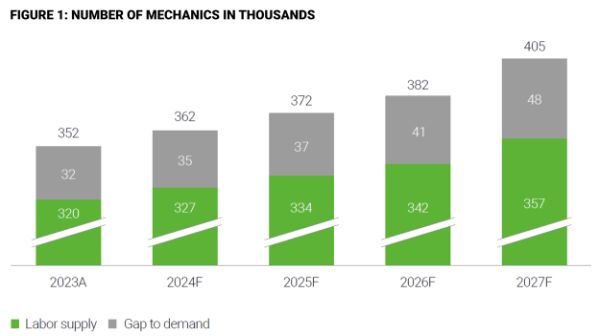Ensuring the airworthiness of aircraft is becoming an increasingly difficult challenge. As the global commercial maintenance, repair, and overhaul (MRO) sector grapples with a potential inability to keep pace with the industry's growth and requirements, a skilled-labor shortage—both in volume and talent level—is an immediate risk to address.
We are seeing heightened expectations for air traffic and aircraft deliveries, generating an estimated 4% annual growth in demand for maintenance mechanics, according to the Bureau of Labor Statistics. While skilled labor is scarce across several industries, this is especially the case for aerospace, where expertise and experience are table stakes for success. This work requires a high level of competence, extreme attention to detail, and the utmost regard for safety.
Skillwork, a staffing agency for trade workers, estimates the overall ratio of baby boomers retiring versus younger workers entering the trades is 5:2, a difficult blow when the available workforce in the U.S. is already constricted. While there is reason to be optimistic about millennial and Gen Z interest levels in skilled trades, there much work left to do. The Government Accountability Office reports a mere 2% annual increase in new technician certifications, hardly enough to fill the MRO's gap.
This shortage is forcing the MRO sector to alter how it views traditional career trajectories. Major airlines, for example, are now recruiting mechanics directly from schools, sidestepping the conventional path through MRO repair shops. This can fulfill a short-term need, but raises questions about the credentials of tomorrow's MRO talent pool.

Creating an action plan
As new recruits lack the proficiency of a 30-year veteran, the industry is facing an equally troubling talent drain alongside its people shortage. To fix this problem, MRO companies need to focus on talent development and identify a variety of operational and strategic levers they can pull. The avenues MRO companies should explore to enhance capabilities include:
- Operational efficiency improvements: An honest and detailed assessment of current processes and practices is crucial. See where you can simplify work environments and streamline workflows to potentially offset the skills gap and accelerate learning. Capitalizing on efficiency gains by optimizing existing systems and frameworks can significantly offset some of the labor supply challenges.
- Talent engagement: Employee engagement is critical to a happy, effective workforce. Encourage team members to contribute ideas for workplace improvements, which boosts motivation and fosters a sense of ownership. Technical training complemented by soft skills development prepares technicians for long-term success.
- Talent attraction through partnerships: Establish flow-through agreements, or pathway programs, to leverage an airline's brand and attract fresh talent straight from school. Guaranteeing placement at a major airline creates a mutually beneficial relationship with the workforce.
- New talent pipeline development: Introduce a career in aircraft maintenance to students in grade school and high school while they're developing interests. Also, focus on attracting and retaining women through initiatives that include modernized leave policies. Less than 3% of MRO jobs are filled by females, according to a recent FAA study.
- Technology enablers: While augmented reality and automation present promising solutions to supplement human capital, they come with inherent costs and challenges. MRO companies must navigate these hurdles carefully to fully leverage benefits. When considering new technology implementations, carefully define intended use cases and the metrics that will demonstrate ROI.
- Shifting from reactive to proactive: For MRO providers that are more digitally advanced, leveraging Industry 4.0 tools—such as digital twins—can predict maintenance events and identify necessary skillsets. Maintaining an up-to-date database of employee skill profiles can unearth cross-training opportunities, broadening the range of services existing workers can support. Implementing a dynamic staffing model enables quick adaptation in a volatile demand environment.
No time to waste
New strategies and technologies are only as effective as the talent base that supports them. Aerospace is under increased quality scrutiny, so reducing mistakes—particularly in the high-profile role MRO providers play—is a non-negotiable priority. MRO has been the root cause of recent commercial aerospace events that, while not fatal, provide a glimpse into a precarious future if the industry remains without a proper labor pool to perform critical maintenance services.
Now is the time for the MRO industry to conduct a comprehensive review and analysis to pinpoint areas of risk and opportunity amid tight labor conditions and an evolving skills shortage. By investing in talent development, optimizing operations, judiciously implementing technology, and adopting a predictive and proactive approach to staffing, the MRO sector can successfully navigate the complexities of the current labor landscape.
The content of this article is intended to provide a general guide to the subject matter. Specialist advice should be sought about your specific circumstances.
